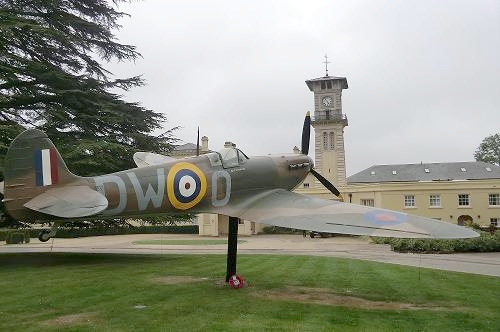The history of Bentley Priory is like no other, this beautiful stately home has seen a rich history through the ages. The origin of its name, was an actual Augustine priory, in neighbouring Harrow Weald not far from where lower priory farm stands today. In 1766 the entire estate was bought by wealthy businessman James Duberly. Duberly had done quite well for himself selling military fatigues, he knocked down the old Priory and erected a sumptuous property at the highest point of his lands ’to show off the evidence of his wealth and importance’. Two decades later when John James Hamilton, the 9th Earl of Abercorn bought the house, he employed the eminent architect, Sir John Soane, to further extend and refurbish the house, hence the basis of the present building was built.
Since those days, the property has become a magnet for people of stature, including Prime ministers William Pitt, George Canning, and The Duke of Wellington, Sir Winston Churchill literary heavyweights Woodworth, Moore, Campbell and Sir Walter Scott. Scott was a frequent visitor, spending much of his time in the summerhouse, writing and revising one of his greatest works, Marmion. For a time, the Priory was home to Royalty as the dowager Queen Adelaide lived there until her death in 1849, and would be visited by her niece, Queen Victoria. Later on, the property was owned and turned into a hotel by the world’s greatest hotelier, Frederick Gordon the acclaimed Napoleon of the hotel world.
But the fortunes of the property changed forever in 1926 when the house and 40 acres of its pleasure grounds were bought by the Ministry of Defence, and became headquarters of Fighter command. For the next 80 years the Priory would have a pivotal role in Britain’s defences. Through the Battle of Britain, D-Day, WW2, the cold war and through various roles in peacetime until its doors finally closed in 2008.
For many in the Royal Air Force, Bentley Priory would always be seen as the spiritual home of Fighter Command, for it was here when we stood alone in Europe, that Air Chief Marshal Sir Hugh Dowding directed, and won the air war over Great Britain, turning our darkest moments into our finest hour. So, it was a fitting tribute that Bentley Priory would be used to house this Battle of Britain Museum.
The museum covers all aspects of the house’s history with the beautifully ornate Adelaide room, photos and literature of the girl’s school and Frederick Gordons hotel, but more importantly the theme is of the vital role that Bentley Priory played in winning the Battle of Britain.
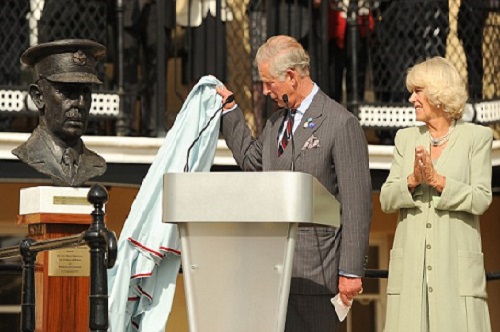
Photo credit Daily Mail / AP
Grand Opening
After eight years of hard work carried out by veterans, volunteers and members of the Bentley Priory Battle of Britain Trust, the opening day had finally arrived.
On 12 September 2013 on a sunny autumn day, the Bentley Priory Museum was officially opened by Prince Charles who is patron of the Trust, and the Duchess of Cornwall. The Opening Address was given by Sir Brian Burridge, Chair of Trustees of the Bentley Priory Battle of Britain Trust. During the ceremony the unmistakable sound of the Rolls-Royce Merlin engine could be heard overhead as a Spitfire and a Hurricane flew low, circling the skies of Stanmore to mark the event. During the day the guests were entertained by Harrow Apollo Male Choir and the Central Band of the RAF.
Prince Charles gave a speech to a crowd including 10 veterans of the air, and eight female Fighter Controllers who assisted them from the ground, tracking enemy movements from the filter room. Charles also unveiled a bust of Air Chief Marshal Sir Hugh Dowding, Fighter Command’s leader who was based here at the Priory during the Battle of Britain. While tea and cakes were served in the vintage Café Charles and Camilla took the time to chat to the veterans and their families, as well as the volunteers without whose hard work the project wouldn’t have got off the ground.
A walk around the museum today both inside and out is such a joy, and credit to all who have been volunteering and working on the project for the past years.
As you approach the Priory from Mansion house Drive, the sight that greets you is quite spectacular, the wonderful architecture of Sir John Kelk’s house with an imposing clock tower, and on the green by the main entrance are two replica fighter planes, a Spitfire and Hurricane these gate guards replaced two earlier ones an English Electric Lightning which is now owned by The Dyson company and a Spitfire that has been restored to flying condition.
Inside Soames elegant entrance hall you can’t begin to imagine it was once someone’s residence, there are stained glass windows one of which is dedicated to The Royal Observer Corps who one had their headquarters here and the fighter command guest book, don’t forget to look up, this wonderful ceiling was lost to time and covered over in white paper. It only came to light when water used to douse the great fire started to peel it off and another of Soames artistic touches was once again discovered.
The Dowding system
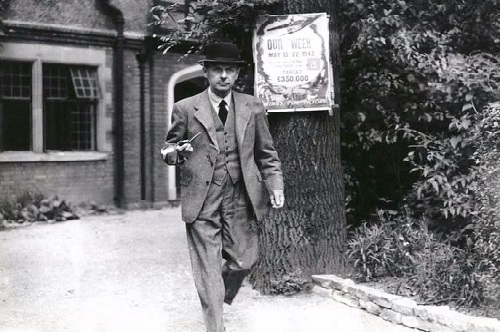
When it comes to The Battle of Britain, the phrase the one the few and the many is often banded around. The pinnacle of this pyramid is the one and, in this case, ’the one’ was Stanmore resident Air Chief Marshall Sir Hugh Dowding who, from his desk at the Priory directed fighter command in the air war against the German Luftwaffe. Britain had been bombed from the air with relative ease in the past and to counter this happening again a strategic air defence system needed to be devised. New technologies were coming on stream all the time, radar, radio telephony but linking them all up was going to be the key to success.
In steps Hugh Dowding, a man on the verge of retirement. Dowding knew we had problems relaying information to the fighters before it was out of date, so he set up an information chain of command. First radar stations called CH ’Chain Home’ Stations scattered across the southern coastline picked up enemy aircraft. This was backed up by a network of spotters from the Royal observer Corps, information would then be passed back to Fighter Command Headquarters here at the Priory. Plotters would then recreate the formation, moving coloured wooden blocks on a gridded map of the UK, each block would note numbers height and direction. Duty Controllers observing from a balcony above the plotters watched and passed on information to group sectors. Each of these groups had a scale map of the one at Bentley Priory and could then contact the control room of the squadrons air base, who would then in turn, scramble their fighters into action.
This protective system was a world’s first and could process huge amounts of information relatively quickly, saving time, money and placing our defensive squadrons exactly where they needed to be to combat the threat from the German bombing raids. The Dowding system was key to the success of the RAF during the Battle of Britain.
Most mornings Dowding would walk from his home ’Montrose’ in Gordon Avenue, a mile and a half or so to his office in Bentley Priory. In 1943 for his contribution to the war effort, Hugh Dowding was given the peerage Lord Dowding of Bentley Priory by King George VI in his birthday honours. Dowding would continue to work at the Priory for the duration of the Battle of Britain.
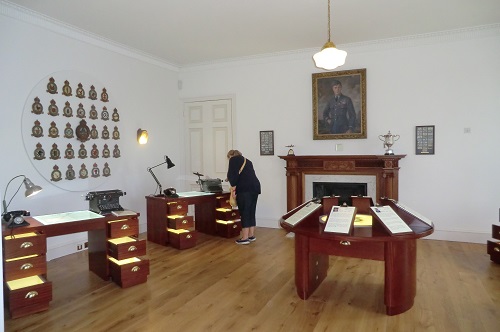
The Abercorn Room
As you step into the ticket office and museum gift shop, notice the stained-glass window above the door. That is the Abercorn Crest, from the days that the Duke of Abercorn owned the Priory. The crest can be seen around Stanmore, on the wall of the gatehouse on the corner of Old Lodge way and once proudly adorned the Abercorn Arms on Stanmore Hill, in the days when it was a public house.
The rooms straight in front of you were once the bedroom and addressing rooms of Queen Adelaide. Adelaide leased the priory in 1846, she was extremely ill with Oedema and found the stairs too difficult to climb, so a bed was bought here for her. Her bed faced the windows with wonderful views of the gardens the lake and Harrow on the Hill on the horizon. It was in this room that she died. The room next door was her dressing room, here she would greet visitors including her niece Queen Victoria.
Queen Adelaide’s last public appearance was to lay the foundation stone of the church of St John the Evangelist, Great Stanmore. She gave the font and when the church was completed after her death, the east window was dedicated to her memory. She died on 2 December 1849 just 57 years old, here in bed, and was buried at St. George’s Chapel, Windsor.
Now called the Abercorn Room it is full of interesting audio-visual displays. One, an interactive mirror gives a timeline history of the priory. Others are uniquely set in a series of desks, amongst other exhibits photos, crests and Fighter squadron badges adorn the walls.
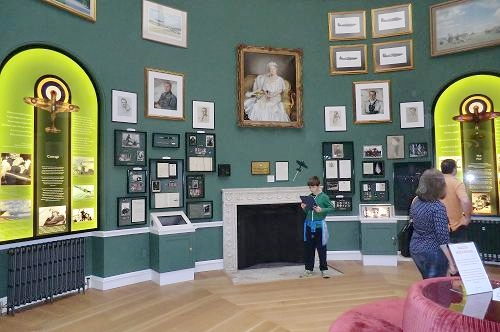
The Rotunda
Just past the Grand staircase you enter the Rotunda. This sumptuous circular room was built by Sir John Soane for the Marquess of Abercorn. Soane loved to build in a neo-classical style and this room is similar to one that he was commissioned top build for the Bank of England. Excellent style for a gallery it allows natural light to enter the room from above.
Adorning the walls to this spectacular room are photos of the heroic Few, each with a brief description of the pilot and his achievements. In a glass case is one of Douglas bader’s artificial legs, manufactured by the Desoutter aircraft company. The fireplace is an original feature of this room and hanging above it is a painting of the Queen Mother. This piece of art painted in oils was given to the priory by the Queen Mum and was hung in the mess from 1982 after she paid for refurbishment following the fire 1979.
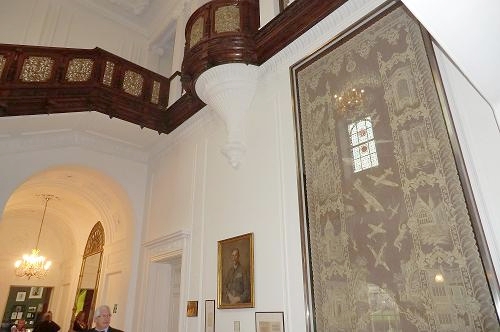
This piece of lace work which was produced by the Nottingham lace making firm Dobson and Browne Ltd, between 1942 and 1946 has been described as probably the most remarkable piece of lace in existence. It was created as a tribute to those who gallantly saved this island. The panel measures 15 feet long and depicts various scenes witnessed during the bombing of London.
A total of 26,000 miles (41,600 kms) of fine Egyptian cotton was used in creating the panel requiring 4,200 threads and the preparation of 975 bobbins
It is hanging opposite the Grand staircase, which was cut out of Portland stone. Most of this area of the Mess was destroyed by the great fire of 1979. Fortunately all of the memorabilia and paintings were in storage at the time. The banisters of this magnificent staircase and the newel pose on the left hand side were faithfully reproduced in 1980-82 by contemporary craftsmen.
The Filter Room
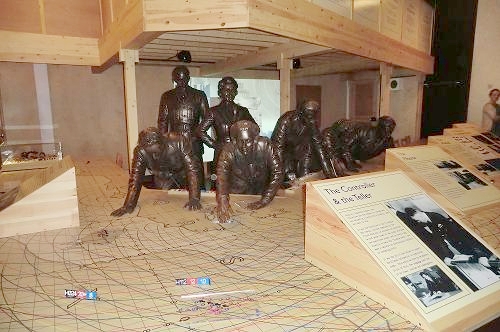
The filter room at Bentley priory received Intelligence on incoming enemy aircraft. Details would be phoned through from different radar stations across the South coast, each piece of information would be filtered and the plotters would place colour coded counters on a gridded map of the UK each one symbolising an enemy formation, including their height and numbers. Most of the plotters were part of the Women's Auxiliary Air Force.
This work was part of the Dowding system and was considered so important that when the bunker was built it, was moved there to avoid the process being disrupted during bombing raids. The whole process was overseen by controllers who were senior officers stationed on a balcony above the filterers overlooking the map. Once the direction and the numbers of enemy aircraft could be established information could be sent out directly to the sector stations to scramble our fighters into action.
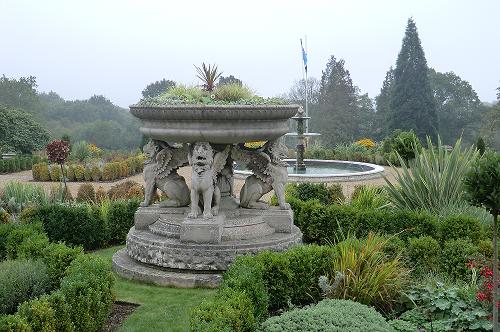
The Italian garden, with its Griffins and various ornaments are authentic and date back over 100 years. On a clear day it has magnificent views over the countryside, as far as Harrow on the Hill. In its heyday the Priory boasted no fewer than 20 gardeners. A Tuscan Portico was added to the garden as well as a magnificent Oriental plane tree which stands below the terrace is one of a collection bought from overseas at the time.
On the ground floor is the vintage café, a great place to stop for a drink and a bite to eat on your visit. The Café serves a variety of light snacks, lunches, cakes and drinks, eat in or sit on the terrace which overlooks the Italian gardens, a perfect place to relax and refuel.
Museum Opening Times
Please note due to changes during the coronavirus pandemic opening times are subject to change
Please check the museum website for the latest times.
The Address is: Bentley Priory Museum Mansion House Drive Stanmore HA7 3FB
For Sat Navs please use postcode HA7 3HT which brings you to the main gates of the museum.
For more information please visit their website
